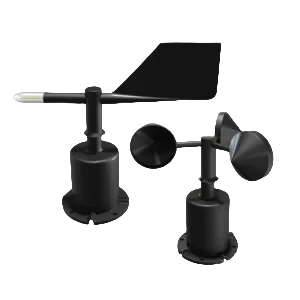What Is a Cup Anemometer and How Does It Work?
Wind is a strong force of nature. People have been interested in it for many years. Measuring wind speed helps us understand the weather. It is also important for flying, renewable energy, and climate studies. A common tool to measure wind speed is the anemometer cup.
This tool has been used for a long time. Let’s take a closer look at its design, how it works, and why it matters in different fields.
Understanding Wind Speed
Before we see how a 3-cup anemometer wind works, we need to know about wind speed. Wind speed tells us how fast air moves sideways in a specific area.
It is usually measured in three ways. These are meters per second (m/s), kilometers per hour (km/h), and miles per hour (mph). The unit used can depend on the context or region.
Anatomy of a Cup Anemometer
A cup anemometer is a simple tool that measures how fast the wind blows. It has several round cups as its main part.
We put the cups evenly on the flat arms. These arms connect to a central vertical shaft. Most models have three or four cups spaced out equally.
When the wind blows into the cups, the whole assembly starts to spin. The vertical shaft holds the rotating arms and cups. It connects to parts inside the device. These parts change the spinning motion into data that can be collected and studied.
Advanced cup anemometers often have electrical parts that turn movement into electronic signals. These signals go to a display or recording device. This gives precise measurements about the wind speed.
How Does a Cup Anemometer Work?
The cup anemometer is based on a simple idea. Stronger wind makes the cups spin faster. It counts how many times the cups turn in a set time.
Then, it uses that to find the wind speed. The size, shape, and spacing of the cups are changed to make sure it is accurate.
Electric sensors in the anemometer create pulses for each full turn of the cups. The number of pulses is directly linked to how fast the cups spin. This speed acts as a stand-in for wind tunnel speed. The data is then processed with math formulas to give accurate measurements.
One limitation of cup anemometers is that they smooth out fast changes in wind speed. Their design makes them better at measuring average wind speeds. They do not capture sudden gusts or quick changes in air flow very well.
Advantages of Cup Anemometers
Cup anemometers have become an essential tool in many industries due to their numerous benefits:
1. **Accuracy and Dependability**: These devices are very reliable. They give consistent wind speed data in different conditions.
2.**Resilience**: They work in tough places. They do well in extreme weather and need little care.
3. **Energy Efficiency**: They use very little power. This makes them great for remote or off-grid areas with limited energy.
4. **Ease of Use**: Their simple design makes them easy to install, use, and care for. This lowers the risk of mechanical issues.
Final Thoughts
The cup anemometer shows how simple design can lead to great results. It gives accurate and reliable wind measurements.
This is a key tool for weather, aviation safety, renewable energy, and more. It is strong, efficient, and simple to use. This classic instrument is still important for understanding wind patterns in many places.
Applications of Cup Anemometers
Cup wind vane anemometers are widely used in many industries. They play an important role in measuring the speed of the wind. Here are some of the main ways they are used:
1. Meteorology:
These devices are important for weather experts at stations. They help in making weather forecasts. They give accurate wind speed readings.
This helps predict weather patterns. It also sends alerts for severe weather, like hurricanes and tornadoes.
2. Aviation:
Reliable wind speed data from cup anemometers is important for pilots and air traffic controllers. It helps keep takeoffs and landings safe. This data also helps in planning flight paths. Wind affects how planes fly and move.
3. Wind Energy:
The renewable energy sector uses cup anemometers to measure wind speeds at potential turbine sites. This data helps us choose good locations for wind farms. It also improves energy production and plans maintenance for turbines.
4. Research and Environmental Monitoring:
These tools help with studies on climate change, weather events, and air quality. The information they provide helps us understand ecosystems and how they connect with people.
5. Outdoor Activities and Sports:
Cup anemometers are useful for outdoor lovers and professionals. They help with activities like sailing, paragliding, and kite flying. These devices give you wind speed data in real time. This information helps users check conditions for safety and efficiency.
Conclusion
In conclusion, cup anemometers are important for measuring wind speed in many places. Their simple and strong design helps gather data consistently. This makes them very helpful in areas like weather forecasting, flying, renewable energy, environmental studies, and outdoor activities. By understanding their value, we can see how they help technology and their role in our daily lives.
Hunan Coda Electronic Tech Co., Ltd. is a trusted name for high-quality products. They focus on what customers need. The company focuses on making OEM sensors. They offer custom solutions for advanced systems that watch the environment.
Hunan Coda has many years of experience in making weather tools. They offer a wide range of devices, such as wind sensors, rain gauges, soil sensors, and water sensors. Research shows that OEM sensors make monitoring more accurate and lower risks. This shows that their products are reliable.
When searching for environmental monitoring tools, it is important to pick a trustworthy supplier. Hunan Coda Electronic Tech Co., Ltd. stands out with high-quality instruments that work well. This makes them a top choice in the industry.
